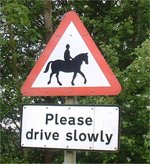What is a
Hazard?
A hazard is anything that
may cause you as a driver or rider to change speed or direction.
Broadly speaking hazards can be broken down into three
categories;
| Static hazards
are features on the road that do not
change. Examples would be bends, road junctions, roundabouts,
pedestrian crossings. When approaching these you may have to
change speed and/or direction. You may also have to take into
account the action of other road users, such as at a
junction. |
 |
Moving hazards
can generally be classed as other road
users. These include car drivers, motorcyclists, cyclists,
pedestrians, bus/lorry drivers, horses and other animals. You
will need to be aware of each of these road users for
differing reasons;
-
cyclists
may swerve to avoid objects on the road such as drain
covers,
-
bus and
lorry drivers need more room to manoeuvre,
-
horses
and other animals may be easily startled,
etc.
|
 |
Environmental hazards
include the weather and lighting conditions.
Some examples are;
-
A bright
setting sun in the autumn can affect your
visibility
-
Rain
will increase your stopping distance
-
Snow or
ice will increase your stopping distance by at least ten
times
-
Night
time can make it difficult to see other road users (particularly
cyclists and pedestrians) and to judge the speed and position of
other road users.
 |
 |
| 
